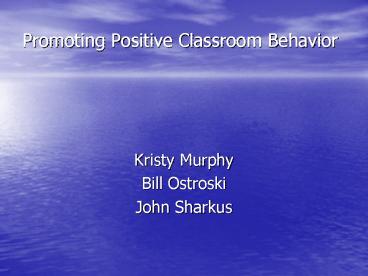Promoting Positive Classroom Behavior - PowerPoint PPT Presentation
1 / 17
Title:
Promoting Positive Classroom Behavior
Description:
Promoting Positive Classroom Behavior. Kristy Murphy. Bill Ostroski. John Sharkus. Misconceptions ' ... By junior or senior high school, students know the ... – PowerPoint PPT presentation
Number of Views:816
Avg rating:3.0/5.0
Title: Promoting Positive Classroom Behavior
1
Promoting Positive Classroom Behavior
- Kristy Murphy
- Bill Ostroski
- John Sharkus
2
Misconceptions
- My kids arent babies. By junior or senior high
school, students know the importance of coming to
class on time, doing homework, respecting other
peoples property, and raising their hands to
make a comment. Besides, theres so much material
to cover, I cant waste time teaching rules to
kids who should already know this stuff.
3
Misconceptions
- Rules vary from classroom to classroom
- Teacher specific expectations
- Basic classroom routines
4
Research on Classroom Behavior
- Preventive Discipline Practices
- Commitment, on the part of all staff, to
establishing and maintaining appropriate student
behavior as an essential precondition of learning - High behavioral expectations
- Clear and broad-based rules
- Warm school climate.
5
Research (cont.)
- A visible, supportive principle.
- Delegation of discipline authority to teachers.
- Close ties with communities
- Practices for Enforcing School Rules
- Punishment, in some forms
- Counseling
- In-school suspension
- Contingency contracting
- Home-based reinforcement
6
Research (cont.)
- J. S. Kounin, Discipline and Group Management in
Classrooms, 1970 - Behaviors of teachers that keep students focused
on learning with minimal disruptions - Withitness
- Overlapping
- Smoothness and momentum in lessons
- Group alerting
- Stimulating seatwork
7
Defining Your Expectations for Behavior
- Four Principles for Planning Classroom Rules
(Table 4-1, p. 58) - Rules should be reasonable and necessary
- Rules need to be clear and understandable
- Rules should be consisted with instructional
goals and with what we know about how people
learn - Classroom rules need to be consistent with school
rules
8
Guidelines for Developing Classroom Rules
- Establish rules early
- Involve students
- Limit the number of rules
- State rules positively in short, clear terms
- Identify rewards and consequences
- Post rules and have a copy for each student
- Practice and review frequently
- Inform parents
- Monitor behaviors systematically
- Enforce rules consistently
9
Classroom Routines
- Class-Running Routines
- Nonacademic routines that allow smooth classroom
execution - Taking attendance
- Distributing School notices
- Procedures for student movement
- Cleaning the classroom
10
Classroom Routines (cont.)
- Lesson-Running Routines
- Behaviors necessary for teaching and learning to
take place - Knowing what materials they need
- Format for graded assignments
- How they should behave during a lesson
- What should be done if students finish
assignments early, or do not finish on time
11
Classroom Routines (cont.)
- Interaction Routines
- Rules for speaking in class
- Talk between teacher and student
- During class discussions
- When the teacher needs the students attention
- When a/the student(s) need the teachers
attention - Talk among students
12
B.I.P.
- Behavioral Intervention Plan
- Used for students with I.E.P.s
- Alerts the teachers as to how to deal with student
13
F.B.A.
- Functional behavior assessments
- Required by IDEA
- Evaluation process
14
10 step process
- Determine the function of the undesired behavior
- Determine an appropriate replacement behavior
- Determine when replacement behavior should occur
- Design a teaching sequence
15
10 step process (cont.)
- Manipulate the environment to increase the
probability of success - Manipulate the environment to decrease the
probability of failure - Determine how positive behavior will be
reinforced - Determine consequences for instances of problem
behavior
16
10 step process (cont.)
- Develop a data collection system
- Develop behavioral goals and objectives
17
Sources
- Schoolwide and Classroom Discipline
- School Improvement Research Series (SIRS)
- www.nwrel.org/scpd/sirs/5/cu9.html
- Classroom and Behavioral Management
- Alabama Professional Development Modules
- http//web.uk.edu/mccay/apdm/classmgt/classm
gt_d.htm - A Climate for Learning
- Action in Schools to Promote Positive
Behavior and Reduce Low-Level Disruption - http//www.hmie.gov.uk/documents/publication/
rbblr-05.html - Promoting Academic Success
- Promoting Academic Success via Classroom
Structure































